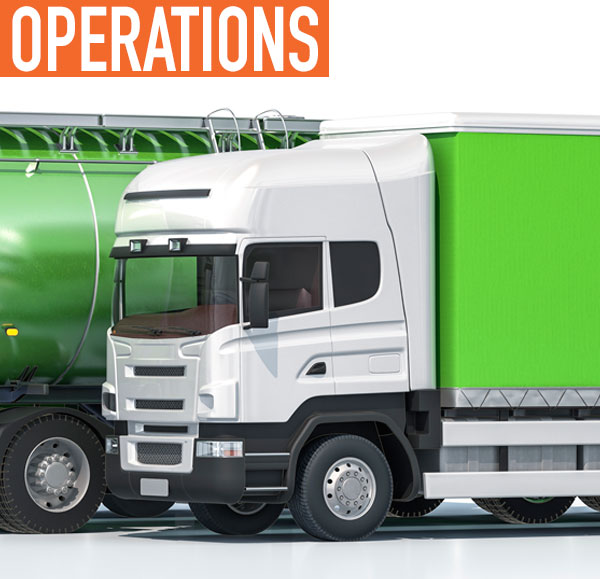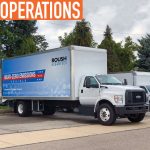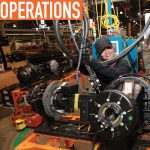Safe, sustainable, and efficient. These are some of the driving forces behind integrating alternative energy/advanced technology into today’s work truck fleets. Along with these driving forces are a multitude of other reasons to convert a traditional gas or diesel fleet into a cleaner burning fuel or electric fleet. But when it comes to fleet conversion, there a few things to consider.
Last month, we discussed some factors to think about before converting your fleet. Vehicle brand preference, range, payload, funding, ROI, and certifications and standards are among those factors. This month we’ll discuss safety, quality, and integrity standards as well as other additional considerations that are sometimes overlooked.
SAFETY, QUALITY, INTEGRITY
The most important concern in altering any design is to maintain a system’s safety, quality, and integrity. Below are some factors to consider:
1 OBD requirements
Beginning in 2018, vehicles with a GVWR exceeding 14,000 lbs must comply with OBD monitoring. With OBD-II being the latest version of diagnostics for most vehicles on the road today, it’s vital to understand any impact an alternative energy/advanced technology system could have when installed. The goal of OBD-II was to access all these diagnostics through one data link connector.
Some alternative energy/advanced technology systems control their performance through a slave computer—not accessible through the vehicle OBD-II data link. Engine operating conditions can still be observed through OBD-II, but the fuel or drive system faults would then be accessible through the slave computer. While this arrangement is neither right nor wrong, it’s important to be aware of the additional location to gather troubleshooting data.
2 Chassis integration and required modifications
Alternative energy/advanced technology system manufacturers and installers should be in close communication with OEMs, allowing access to the latest technical, safety, and quality requirements in order to make appropriate vehicle modifications.
3 Choosing proper partners
Researching the companies that design, build, convert, and install your system is always recommended. Successful integration depends on having quality systems and processes throughout the supply chain. Visiting system manufacturer and installer facilities allows you, as the potential user, to see how the system is produced and installed, providing a reasonable understanding of involved processes. It’s important to verify support structures are in place to prevent any failures in the field and deal with potential problems.
It’s worthwhile to assess a supplier or installer on some subjective factors to boost project success, including engineering capabilities and discipline, corrective action response, and customer reaction.
4 Design best practices
When evaluating the final design of a commercial vehicle with integrated sustainable technology, consider the following suggestions:
• Design the entire integration as a whole, not in pieces;
• Follow vehicle manufacturer design best practices;
• Account for system durability and survivability;
• Have design standards for consistency.
A commercial vehicle upfit is typically comprised of multiple components from different suppliers. It’s important to either work with an upfitter that can oversee the entire vehicle integration or engage several suppliers that overlap to ensure all components are compatible and work well together.

It’s also important to make sure all vehicle manufacturer design best practices are considered. Many vehicle manufacturers publish quality standards, describing best practices to follow and avoid during upfits. These are important for upfit quality and certification testing/criteria during development.An important best practice is to verify the system is designed for durability and survivability. Beyond standards like NFPA for CNG, key considerations include:
• Proper routing of hoses and tubing;
• Protection of key components from road debris and environmental hazards using coatings, shields, and/or enclosures;
• Adequate access for maintenance inspection;
• Exclusive use of high quality fittings and hardware throughout the system;
• Correct mounting of key components to avoid loosening.
A final design consideration involves upfit consistency across many vehicles. Fleets will often buy several vehicles with the same specifications—sometimes at different times. It’s important to identify any key attributes of the upfit to carry through the design.
5 Quality standards
Quality takes various forms and can be held to many standards. Chassis manufacturers have guiding quality standards and certifications. Beyond bodybuilder upfit guides, they provide certain requirements and/or certifications that should be fulfilled. They usually require FMVSS compliance, including crash testing and emissions and tank compliance. These standards help distinguish system upfitters.
MORE TO CONSIDER
Warranty
There are two primary considerations when reviewing a system and vehicle warranty. First of all, it is necessary to understand if the alternative energy/advanced technology system affects the vehicle warranty. In some cases, there are OEM-approved systems in which the warranty remains the same for the vehicle and is seamless to the end customer.
In addition, the system partner may offer a warranty on newly-installed components equivalent to what was removed from the original vehicle. This demonstrates why selecting a reliable system supplier is critical. Any other situations should be closely monitored to avoid sacrificing vehicle coverage in some way.
Hybrid vehicles
Hybrid vehicles are normally defined as having two or more energy sources. In most (but not all) cases, hybrids capture and reuse energy from vehicle braking and/or engine output exceeding vehicle operation requirements. Currently, hybrids can be considered both electric and hydraulic.
Both technologies can be very effective in the proper drive and duty cycle, so a critical factor in hybrid use is properly matching the technology to the application.
The optimal choice between the various hybrid options is determined by drive and duty cycle and vehicle weight and is beyond the scope of this overview. In general, hydraulic hybrids work best in applications where: the vehicle is heavy; is subject to very frequent start/stop cycles (launch/braking); and has a limited high-speed drive cycle component. Electric hybrids are typically preferred when the start/stop cycle is less frequent and there is greater demand for extended operations at intermediate to high speeds. Due to the wide variation in hybrid technologies, to include both OEM and retrofit systems, the potential user should carefully evaluate the applications before making any decisions.
Logistics and ship-thru
Ship-thru and freight reentry are popular options for many end users due to the inexpensive transportation costs. Although there are size restrictions, the ship-thru process can help save costs, especially in more complex upfits.
Upfit cost
Several variables affect total upfit costs. The more complex the job (such as number of tanks, bi-fuel versus dedicated, integration into body, etc), the higher the cost. Number and location of available facilities are important factors to consider.
Now that we’ve discussed all the factors to consider when integrating alternative energy/advanced technology in your fleet, it’s time to learn more about alternative energies in themselves. Stay tuned for next month’s issue where we deliver a breakdown of several different sources of alternative energy in part 3 of Exploring Alternative Energy Solutions.
FOR MORE INFORMATION
The Green Truck Association (GTA) is an affiliate division of NTEA with the goal to continue the progression of green work trucks. The information from this article was adapted from GTA’s white paper, “Sustainable technology integration: Exploring alternative energy solutions.” Find out more, visit www.greentruckassociation.com.
MODERN WORKTRUCK SOLUTIONS: FEBRUARY 2019 ISSUE
Did you enjoy this article?
Subscribe to the FREE Digital Edition of Modern WorkTruck Solutions magazine.





